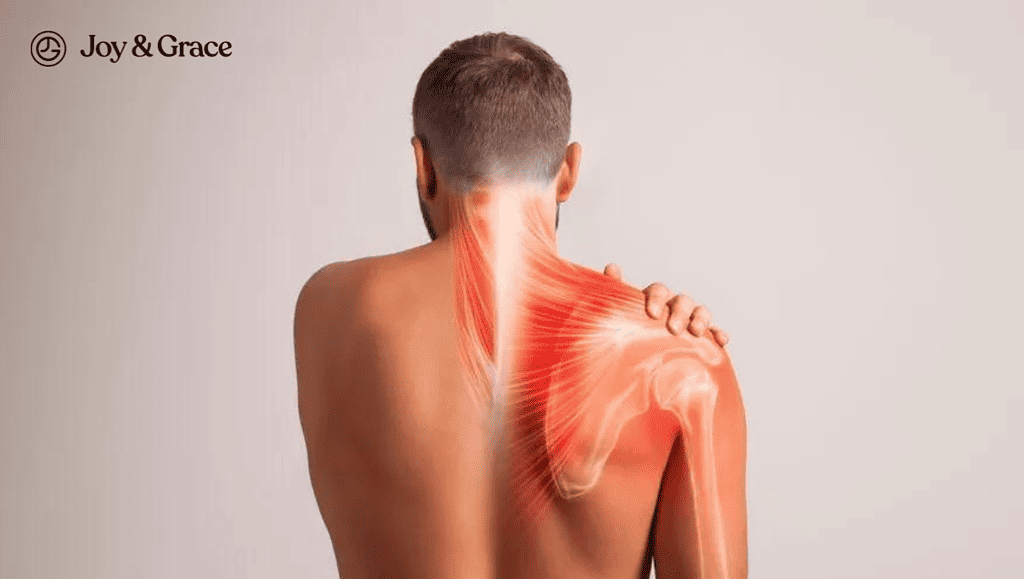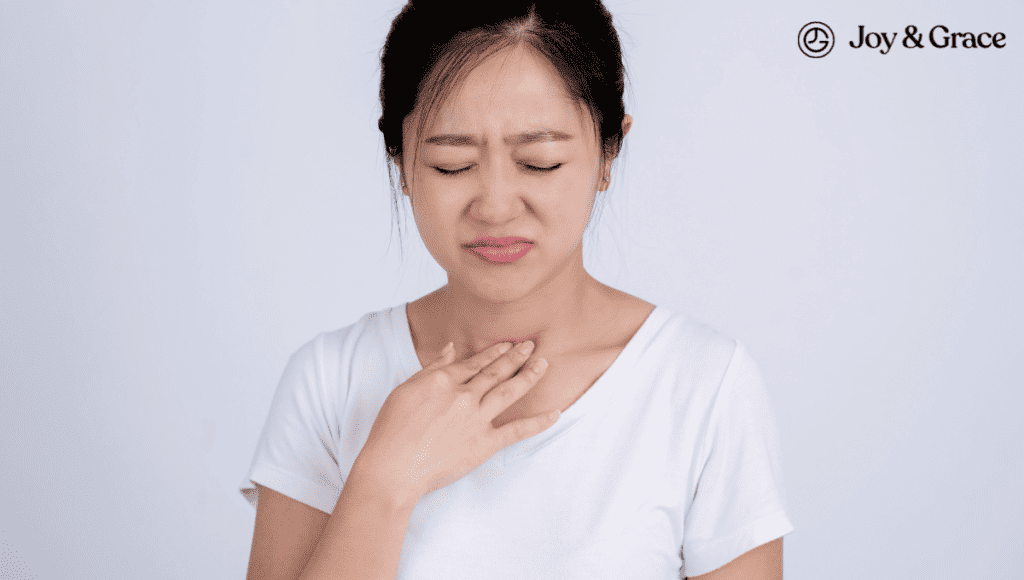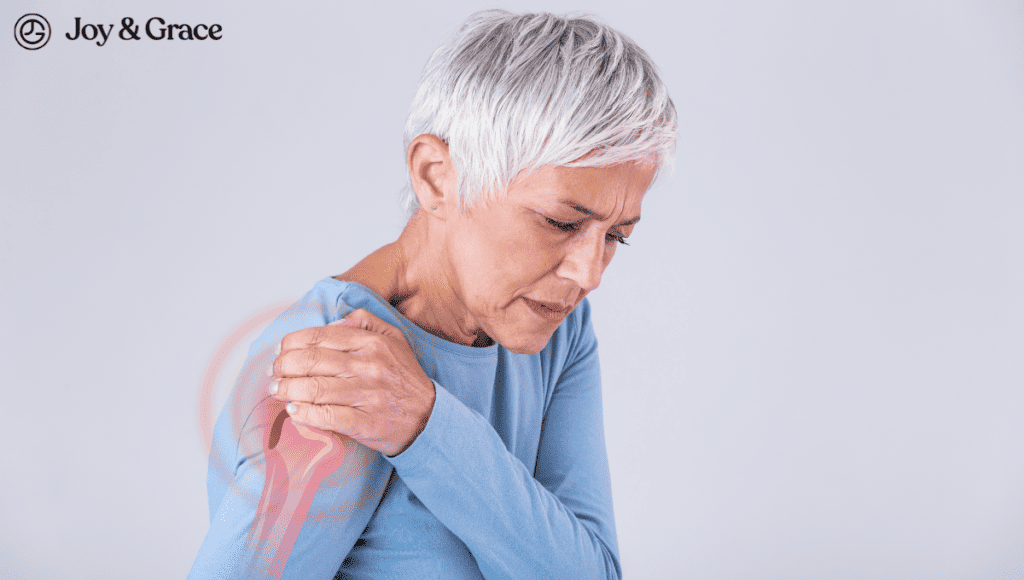You wake up to another day, shrug your shoulders, and in that simple motion, there it is again—that searing jolt of pain on your right side.
It starts from your chest and goes up to your neck. It doesn’t feel just like ordinary discomfort but like a persistent agony that flares up with every breath.
Join us as we examine the possible causes of this pain, its implications, and potential solutions.
What's Causing My Right Upper Chest And Neck Pain?
Pain in your right upper chest and neck can be due to various conditions. We’ve listed some of the possible causes below. But take note: some of these may be more common than others.
- Muscle Strain
Muscle strain or overuse is often the primary cause of upper chest and neck discomfort. Repetitive motions and tasks that involve lifting heavy objects can lead to strain in these muscle groups.
Furthermore, consider this fact: approximately 95% of individuals are right-handed, which may include you.
The significance lies in the fact that when we engage our hands and arms in various activities, we also engage our chest muscles on the right side. As a result, being right-handed increases the likelihood of overusing these muscles, potentially resulting in discomfort or pain in your right upper chest.
If you work on your computer most of the time, you might also have a “mouse shoulder.” A mouse shoulder occurs when the muscles and tendons in the shoulder are overused due to the repetitive movements involved in using a computer mouse for extended periods. Aside from shoulder pain, you might also have pain down your arm, chest, and neck.
Another common cause of muscle strain is poor posture. When the body is not properly aligned, your muscles have to work harder to maintain balance and stability. Over time, this can lead to fatigue and strain in the affected muscles. - Cervical Radiculopathy
Another common cause is cervical radiculopathy or a pinched nerve in your neck. This condition can cause pain radiating down the right side of your neck, chest, and even arm.
Typical symptoms include:
- Tingling or numbness in the fingers or hands.
- Weakness in the muscles of the arm or shoulder.
- Changes in reflexes.
- Rib Injuries
Injuries to the ribs can range from mild bruises to more severe breaks.
Bruises occur when the impact damages blood vessels beneath the skin, causing discoloration and tenderness in the chest area.
These are less severe than rib fractures, which involve a break in the bone.
Rib fractures can lead to localized pain in the chest, especially in the area where the injury occurred. In the case of right-side, upper chest, and neck pain, it may correspond to the right first rib.
Typical symptoms include:- Difficulty breathing or shallow breathing.
- Tenderness and swelling around the injured area.
- Bruising over the ribs.
- Pain that increases with movement or breathing.
- Shingles
Shingles is caused by the reactivation of the varicella-zoster virus. This virus initially causes chickenpox. The pain associated with shingles often begins as a burning or tingling sensation and can then progress to a sharp, stabbing pain.
This pain is typically localized to one side of the body and can affect the chest, including the right upper chest, and may extend to the neck.
Typical symptoms of shingles include:- Itching or burning sensation before the rash appears.
- Sensitivity to touch.
- Fluid-filled blisters that break open and crust over.
- Fatigue and flu-like symptoms.
- GERD
Severe heartburn, or gastroesophageal reflux disease (GERD), could also cause pain above the right breast near the shoulder and the right side of your neck and chest
The main symptoms of GERD are:- Heartburn (burning sensation in the chest).
- Regurgitation of stomach contents into the throat.
- Sour taste in the mouth.
- Difficulty swallowing.
- Costochondritis
Costochondritis is the inflammation of the cartilage connecting your ribs to your breastbone (sternum). Most people with the condition feel pain in the upper and middle chest. Although it typically affects the left side, it can also occur on the right side.
Typical symptoms of costochondritis include:- Tenderness and pain in the chest, specifically near the breastbone.
- Pain that worsens with touch and movement.
It's also worth noting that, albeit more rarely, certain lung conditions can also cause pain in your chest and neck when breathing deeply.
Why Does The Upper Right Side Of My Chest And Neck Hurt When I Breathe?
As mentioned, lung problems can also cause pain on the right side of your chest and neck. Pain from lung problems can be due to two reasons:
- Certain lung problems can cause inflammation. Inflammation can irritate the various tissues of the lungs, which can result in pain.
- Lung problems can also impair your breathing. As a response, your body might use certain muscles in your chest and neck to compensate. This can strain these muscles, resulting in pain.
Possible mechanisms include:
- Pleurisy
Pleurisy is inflammation of the lining around the lungs (pleura). This inflammation can cause chest pain, especially during breathing. The pain from pleurisy is often described as sharp and may be felt on one side of the chest.
Pleurisy can also cause referred pain in your neck and shoulders. This is because the pleura that lines your diaphragm is connected to the phrenic nerve, which connects to the nerves of your neck and shoulders.
Possible causes of pleurisy include:
- Pneumonia, which typically presents with:
- Fever
- Cough (may produce phlegm)
- Shortness of breath
- Chest pain
- Fatigue
- Sweating
- Confusion (especially in older adults)
- Flu (influenza), which typically causes:
- Fever
- Chills
- Cough
- Sore throat
- Runny or stuffy nose
- Muscle or body aches
- Fatigue
- Autoimmune disorders like lupus. These diseases often cause the following symptoms:
- Joint pain and swelling
- Fatigue
- Skin rashes
- Fever
- Chest pain
- Photosensitivity (sensitivity to light)
- A butterfly-shaped rash across the cheeks and nose (a common symptom in lupus)
- Tuberculosis (TB) is a bacterial infection that typically causes the following symptoms:
- Persistent cough (often with blood-tinged sputum)
- Night sweats
- Weight loss
- Fatigue
- Persistent fever
- Chest pain
- Loss of appetite
- Lung cancer, which typically presents with the following symptoms:
- Persistent cough
- Coughing up blood
- Unexplained weight loss
- Chest pain that worsens with deep breathing or coughing
- Shortness of breath
- Fatigue
- Hoarseness
Conditions such as hyperventilation syndrome or dysfunctional breathing can lead to chest pain. These disorders cause abnormal breathing patterns and are usually the result of other conditions, like:
- COPD (Chronic Obstructive Pulmonary Disease). COPD is a long-term lung problem where it gets harder to breathe over time. It’s usually due to smoking and can cause the following symptoms:
- Shortness of breath, especially during physical activity
- Chronic cough with mucus production
- Wheezing
- Chest tightness
- Fatigue
- Recurrent respiratory infections
- Asthma. Asthma is a condition where your airways get inflamed, making breathing tough. It’s often triggered by allergies or exercise, and it causes the following symptoms:
- Shortness of breath
- Wheezing (a whistling sound when breathing)
- Cough, especially at night or early in the morning
- Chest tightness
- Rapid breathing
- Difficulty in speaking due to shortness of breath
- Fatigue
- Anxiety
- Extreme stress
Keep in mind that breathing can also make the pain from the conditions we mentioned earlier worse.
Can Right Side Neck And Chest Pain Be Heart-Related?
While pain in the right upper chest and neck can potentially be heart-related, it’s more likely due to the conditions mentioned above.
Pain from heart conditions, like a heart attack, usually causes pain in the center or left side of your chest. However, heart-related pain can sometimes manifest on the right side as well. But don’t panic just yet. Heart-related pain has a specific characteristic and rarely appears on its own.
It’s usually described as a crushing or tight sensation, often triggered by physical activity or emotional stress. This is why it’s usually depicted in the movies as a person clutching their chest. In fact, there’s a medical term for this gesture: the Levine sign.
Furthermore, heart-related chest pain also radiates to other areas of your body, such as the arm, shoulder, back, or neck.
Seeking emergency medical care is crucial if chest pain occurs along with:
- A racing or irregular heartbeat
- Shortness of breath
- Nausea
- Dizziness
- Fatigue
- Loss of consciousness
If you’re experiencing chest and neck pain with these symptoms, seek medical attention right away.
What Can I Do At Home To Treat Right-Sided Chest And Neck Pain?
The best way to treat pain in your right upper chest and neck is to treat the underlying cause. This requires a proper medical evaluation from a doctor.
However, this doesn’t mean that you can’t do anything about it.
Below are some simple remedies you can try to relieve the pain at home. While they might not work for everyone, they are unlikely to cause any harm if tried.
- Practice gentle neck and chest exercises.
This can help reduce muscle tension and relieve pain from muscle strains. However, the stretches should be gentle and controlled. Avoid any movements that cause sharp or intense pain.
Another thing: consult your healthcare provider before engaging in any exercise routine. - Rest and avoid strain.
On the flip side, it’s also important that you get adequate rest and allow your body to heal. As mentioned, avoid activities that may strain your chest and neck muscles. These include heavy lifting and other rigorous forms of exercise. - Cold therapy
An ice pack can relieve pain and inflammation in the area. Cold therapy is usually done during the acute phase of the injury. Apply an ice pack or ice wrapped in cloth to the injured area for 15 minutes for the first 24-48 hours after the injury. - Consider a warm compress.
Warmth can also help relax tense muscles, resulting in pain relief. A warm towel or a heating pad can be applied over the painful area for up to 20 minutes.
It’s important to note that heat therapy should be avoided when inflammation is present. The heat can increase blood flow to the area and worsen inflammation. - Avoid trigger foods.
If your pain is related to digestive issues, consider avoiding foods that may trigger symptoms, such as spicy or acidic foods. - Use over-the-counter pain relievers if necessary.
OTC medications like ibuprofen and acetaminophen can provide temporary relief from chest and neck pain. Do remember that these are meant for short-term use and are not a substitute for long-term solutions. Furthermore, it’s important that you follow dosage instructions to avoid any side effects.
If your pain persists, gets worse, or comes with any other unsettling symptoms, always seek medical attention. Remember, self-diagnosis may lead to complications. So, we always recommend professional evaluation.
How Is Right-Side Chest And Neck Pain Treated?
Treatment often varies depending on the cause. For example, chest and neck pain due to muscle strain often only requires the abovementioned conservative methods.
In contrast, pain from costochondritis or a pinched nerve may require the following:
- NSAIDs
- Physical therapy
- Prescription medication like:
- Corticosteroids
- Anti-depressants
- Anti-seizure drugs
- Opioids (in extremely severe cases)
Surgery is usually done when your condition is unresponsive to the treatments mentioned.
If the pain in your right upper chest and neck is from GERD, the following medications might be needed:
- Antacids
Over-the-counter antacids can provide temporary relief by neutralizing stomach acid. - H2 Blockers (Histamine-2 Receptor Antagonists)
They reduce the production of stomach acid. Examples include ranitidine and famotidine. - Proton Pump Inhibitors (PPIs)
PPIs are more potent than H2 blockers and reduce the production of stomach acid more effectively. Examples include omeprazole, esomeprazole, and lansoprazole.
Like cervical radiculopathy and costochondritis, surgery may be done if your GERD is unresponsive to medication.
How Do I Get Rid Of Chest Pain On The Right Side When Breathing?
Treating the underlying cause will also get rid of chest pain when breathing. For example, if your pain is from pneumonia, a course of antibiotics will do the trick. Since there are a lot of possible causes, it’s important to get a proper medical evaluation. Your medical treatment plan depends on an accurate diagnosis.
If you suffer from a breathing pattern disorder, you can also do breathing exercises. A good example is diaphragmatic breathing. Here’s a quick guide on how to do it:
- Find a comfortable, flat surface and lie down with your knees bent and feet planted firmly on the ground.
- Position one hand on your chest and the other on your abdomen.
- Inhale gently, focusing on the rise of your abdomen, and exhale, allowing it to fall back into place naturally.
- Concentrate on minimizing movement in your upper chest. Instead, channel the breath through your nose quietly, keeping your mouth closed throughout the process.
What Are The Possible Complications Or Risks Of Not Treating Right-Sided Chest And Neck Pain?
Like the treatment, it also depends on the cause. Take note that these complications don’t always happen and can depend on the severity of your condition as well as your overall health.
- Musculoskeletal problems (muscle strains or rib injuries):
- Chronic pain, impaired range of motion, and potential complications related to reduced physical activity or postural problems.
- Rib fractures might result in injuries to the organs directly under the affected rib.
- Neurological issues (cervical radiculopathy):
- Complications may include persistent pain, weakness, and neurological deficits if the underlying issue is not addressed.
- Complications may include persistent pain, weakness, and neurological deficits if the underlying issue is not addressed.
- Digestive issues (acid reflux):
- Complications may involve esophageal damage or the development of ulcers.
- Complications may involve esophageal damage or the development of ulcers.
- Lung conditions (pleurisy):
- Untreated respiratory infections can lead to complications, such as:
- Respiratory failure
- Pleural effusion
- The spread of infection to other parts of the body
- Untreated respiratory infections can lead to complications, such as:
- Heart-related issues (e.g., angina, heart attack):
- Complications may include:
- Heart damage
- Myocardial infarction (heart attack)
- Arrhythmias
- Heart failure
- In severe cases, death
- Complications may include:
When Should Right-Side Chest And Neck Pain Be Treated By A Doctor Or Healthcare Provider?
While most cases of pain in the right upper chest and neck are mild and can be treated conservatively, some may be medical emergencies.
As mentioned, seek medical attention if you experience the following:
- Severe or persistent pain
- Pain that significantly affects your daily life
- Shortness of breath
- Nausea or vomiting
- Sweating
- Dizziness or lightheadedness
- Numbness
- Weakness
- Fatigue
- High fever
- Cough
Takeaway
Right-sided chest and neck pain can have several potential causes. These symptoms can range from something as simple as a muscle strain to something more serious, like lung disease. These causes require different treatment approaches.
Getting an accurate diagnosis from your doctor is important for receiving appropriate care. While alarming, these symptoms don't necessarily indicate a life-threatening condition.
While waiting for a diagnosis, there are some simple solutions you can do at home to help you find relief. These are mainly lifestyle changes, such as rest and gentle exercise.
Remember to pay attention to your symptoms and be your own health advocate!















